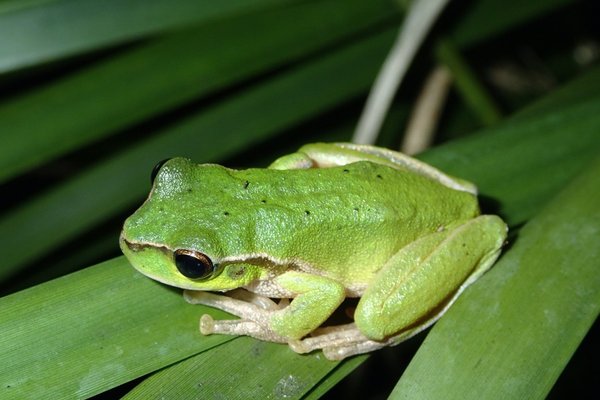The unique frogs of the Solomon Islands: free from a deadly fungus?
The amphibian chytrid fungus, responsible for causing frog declines around the world, may not yet have reached the Solomon Islands.

Solomon Island Giant Treefrog (Cornufer hedigeri), known in Kwaio as the Da`a Da`a.
Image: Jodi Rowley© Australian Museum
Disease is a threat not just to humans, but also to biodiversity. The most devastating wildlife disease known is chytridiomycosis. Caused by the amphibian chytrid fungus (Batrachochytrium dendrobatidis), this disease is likely to have caused declines in hundreds of frog species across the globe. The amphibian chytrid fungus is thought to have been spread around the world by human movements, however one region appears to still be a safe-haven from the amphibian chytrid fungus - Melanesia. Surveys of frogs in Papua New Guinea and Fiji have, as yet, not detected the fungus. However, there have been few surveys and much more research is needed.

Solomon Island Eyelash Frog (Cornufer guentheri), known in Kwaio as the Kule`a.
Image: Jodi Rowley© Australian Museum
As part of collaborative biodiversity research led by the Kwaio community, we conducted frog surveys in East Kwaio on the island of Malaita in the Solomon Islands to try and determine the presence or absence of the amphibian chytrid fungus there. We tested eight frog species, including the Solomon Island Eyelash Frog (Cornufer guentheri), or the Kule`a in Kwaio language. With soft spikes over the eyes, and an array of colours and patterns, the Kule`a is typically found on the forest floor. We also tested the Solomon Island Giant Treefrog (Cornufer hedigeri), found up in the thick forest canopy; known in Kwaio as the Da`a Da`a, the Da`a Da`a has a deep, repeated call heard throughout the night.

Stream in East Kwaio on the island of Malaita in the Solomon Islands.
Image: Jodi Rowley© Australian Museum
The sites we surveyed included rainforest streams at high elevations (>900 m elevation), which are likely to be suitable environmental conditions for the amphibian chytrid fungus (relatively cool and wet). In total, we tested 200 frogs for the amphibian chytrid fungus, and to our relief, all samples tested negative!

Swabbing frogs for the amphibian chytrid fungus (Batrachochytrium dendrobatidis) in the Solomon Islands.
Image: Jodi Rowley© Australian Museum
Further surveys for the amphibian chytrid fungus are needed across the Solomon Islands archipelago to confirm it is truly absent there. However, we believe that a precautionary approach should be taken, assuming that the amphibian chytrid fungus has not yet been introduced to the Solomon Islands archipelago and that native amphibians may be at risk of impact if it is. We believe that strategies should focus on preventing its importation, including via tourism, logging, and mining activities.
The Solomon Islands archipelago is home to a unique and culturally important frog fauna. Although there is still so much to learn scientifically about the frogs of the region, there is extensive traditional knowledge that demonstrates how important they are. Protecting the frogs of the Solomon Islands from the potentially devastating impacts of disease is vital.
Maasafi Alabai, Tommy Esau, Esau Kekeubata, Dorothy Esau
Kwainaa’isi Cultural Centre & Baru Conservation Alliance
Jackson Waneagea, Lamanai`a Lobotalau, James Alick, John Silas, Ledison Solome, Jimson Waneagea, Kwai`ikwala Mousisi
Kwainaa’isi Cultural Centre
Timothy Cutajar, Christopher Portway
Australian Museum Research Institute
David MacLaren
College of Medicine and Dentistry, James Cook University, Cairns
Jodi Rowley
Australian Museum Research Institute & UNSW Sydney
More information
Alabai, M., Esau, T., Kekeubata, E., Esau, D., Waneagea, J., Lobotalau, L., Alick, J., Silas, J., Solome, L., Waneagea, J., Mousisi, K., Cutajar, T.P., Portway, C.D., MacLaren, D.J., & Rowley, J.J.L. (2020). Apparent absence of the amphibian chytrid fungus (Batrachochytrium dendrobatidis) in frogs in Malaita Province, Solomon Islands. Pacific Conservation Biology. https://doi.org/10.1071/PC20047
Acknowledgements
For their hospitality and hard work in the field we are indebted to Bukele, Taawa`i, Etaalamo, Faaisia, Fifanabe`u, Fotageni, Fou`asua, Jimson, John, Kotoringi, Laete`esafi, Lamanai`a, Lengari`i, Loni, Lo`ubata, Maageni, Naata, Nabe, Rubeamae, Sale, Susufia, Tagwa, Telegeni and Wedi. Funding for our fieldwork was provided by the Australian Museum Foundation (AMF), to whom we are extremely grateful.

Swabbing frogs for the amphibian chytrid fungus (Batrachochytrium dendrobatidis) in the Solomon Islands.
Image: Jodi Rowley© Australian Museum













